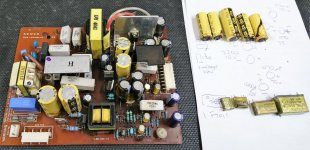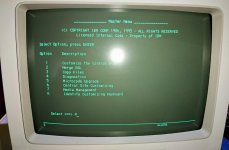I thought I might share my efforts at establishing 3270 terminal communications with a Hercules emulated IBM 370 mainframe OS using real hardware.
I started with the repair and rebuild of a IBM 3191 coax connected terminal aka 'green screen' that left the IBM factory in 1988. I somewhat rashly plugged this in after retrieving it from 20 years of storage and within a few minutes copious quantities of smoke came out. Most of it being burnt polypropylene but the smoke was also laced with tinges of the slightly tarter blown electrolytic smell.
Now it today's health, safety, and litigious environment I need to plainly state that unless you are completely familiar with high voltage electronics don't try this at home. All CRT terminal use high voltages and the 3191 uses 12,000 volts to accelerate electrons towards the phosphor screen.
After disassembly it was clear that the class X2 RIFA polypros had blown (these are almost mandatory to replace with old machines) and most of the electros too (most often happens in switched mode power supplies). Here is a shot of the power supply board on the bench with the dead caps set out on the right and the clean-up and repaired board on the right:

The yellow electros left on the board were still OK but might need replacement in future.
After putting the PSU board back in its metal case and mounting that back in the monitor, a quick bench test showed all the right voltages on the power supply plug:

Then after some major cleaning effort on the case this was the result when testing against a 3174 controller:

Result!
I started with the repair and rebuild of a IBM 3191 coax connected terminal aka 'green screen' that left the IBM factory in 1988. I somewhat rashly plugged this in after retrieving it from 20 years of storage and within a few minutes copious quantities of smoke came out. Most of it being burnt polypropylene but the smoke was also laced with tinges of the slightly tarter blown electrolytic smell.
Now it today's health, safety, and litigious environment I need to plainly state that unless you are completely familiar with high voltage electronics don't try this at home. All CRT terminal use high voltages and the 3191 uses 12,000 volts to accelerate electrons towards the phosphor screen.
After disassembly it was clear that the class X2 RIFA polypros had blown (these are almost mandatory to replace with old machines) and most of the electros too (most often happens in switched mode power supplies). Here is a shot of the power supply board on the bench with the dead caps set out on the right and the clean-up and repaired board on the right:

The yellow electros left on the board were still OK but might need replacement in future.
After putting the PSU board back in its metal case and mounting that back in the monitor, a quick bench test showed all the right voltages on the power supply plug:

Then after some major cleaning effort on the case this was the result when testing against a 3174 controller:

Result!
